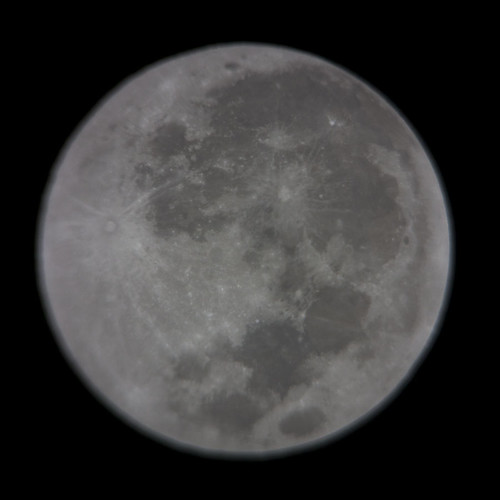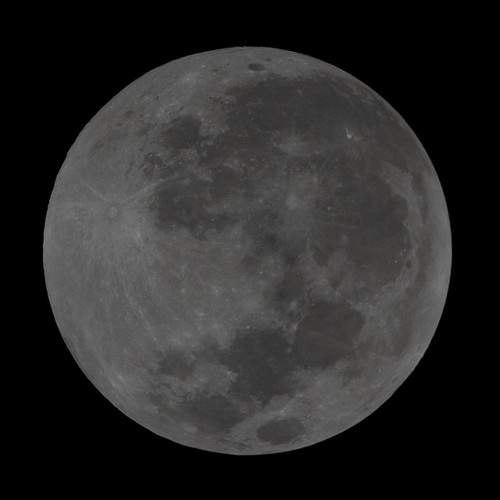I set up my Meade 645 6" f/5 telescope in the back yard, and spend maybe half an hour leveling it and getting it into polar alignment, more or less. Then I adjusted the finder scope and collimated the mirrors, so as to get the best possible images. After the sun went down and the full moon came up, I attached The Wife's Canon 50D camera to the telescope via a T-mount camera adapter, with a 25mm eyepiece in the adapter barrel. Using the camera's Live View feature to get accurate focus, I shot some test images, and was disturbed by the following:

Yes, the center is certainly sharp, but what's with that halation around the edges of the moon? I tried different size eyepieces. No difference--the center remained sharp, but the further out from center the fuzzier the image got. After about an hour of failed troubleshooting, I tried one last gambit. My telescope is designed to act as a lens for the camera, with no eyepiece in between. This is called "prime" photography. The downside is that I'm stuck at one focal length--that of the telescope--and can't swap out the magnification as with eyepiece projection. Also, the primary mirror of the 'scope has to be moved forward in the barrel several inches to make up for the focal difference between the human eye and camera, which means that in this configuration, it is useless for eyeball astronomy. It simply won't focus for human viewing. Still, I thought it worth the hassle if I could get some sharp eclipse images--and if the halation was still present, I'd know the fault lies with the mirrors of my telescope, or perhaps my crummy collimation. Here's my first test shot using the telescope as a prime lens:

Wow! Quite a difference, eh? I don't think I've ever taken an astrophotograph that sharp before. I was happy. Yes, the moon would be smaller this way without the eyepieces to magnify, but I could tolerate that in exchange for, you know, decent images. I was ready for the eclipse!
Then the high fog rolled in. Low clouds, whatever. Streaming up from the south, the misty stuff was like sheer curtains billowing across the moon, obscuring it one moment before clearing out for half a second of almost-clear viewing. The forecast had called for generally clear skies, with maybe partial clouds later in the evening. Nobody had said anything about this. I vowed to wait it out. Surely it would clear out, right? Around 12:30 a.m., just as the moon was entering the umbra of the Earth's shadow, I tried to shoot between the clouds, or at least through the thinnest areas blowing by overhead. The results were uniformly disappointing. Even in the thinnest sections too much light was lost for good exposure--below is the best capture I managed, and even this--over-dark though it may be--was brightened up considerably in Photoshop:

On the bright side, I've become a believer in my telescope's ability to take sharp astronomical photos, even if it wasn't able to show off with the eclipse. My particular telescope is a short-barrel Newtonian, designed back in the '70s for wide-field, deep space astrophotography. We've got plenty of clear winter nights coming up in the next few months, so hopefully I'll have an opportunity to turn it toward the Orion Nebula or the Pleiades and other cool celestial spectacles. We'll see if my sharp lunar image above is a fluke or if I replicate that focus on a regular basis.
Now Playing: The Kinks Low Budget

No comments:
Post a Comment